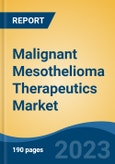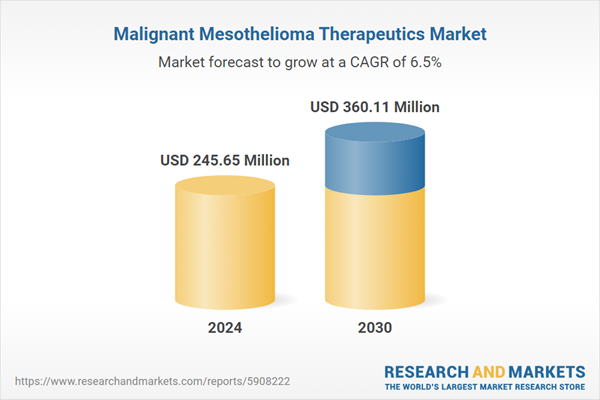Free Webex Call
The Malignant Mesothelioma Therapeutics Market was valued at USD 245.65 Million in 2024, and is expected to reach USD 360.11 Million by 2030, rising at a CAGR of 6.54%. Malignant mesothelioma is a rare and aggressive form of cancer that affects the mesothelial cells lining the chest, abdomen, and heart. This disease is primarily associated with asbestos exposure, and its prognosis is often bleak. However, recent advancements in the field of oncology and the pharmaceutical industry have given rise to a growing market for malignant mesothelioma therapeutics. While malignant mesothelioma remains relatively rare, its incidence has been increasing globally. Speak directly to the analyst to clarify any post sales queries you may have.
10% Free customizationThis report comes with 10% free customization, enabling you to add data that meets your specific business needs.
This is partly due to delayed diagnoses and the long latency period associated with asbestos exposure. Improved diagnostic techniques, including biomarker identification and imaging technologies, have enabled earlier detection of mesothelioma. Early diagnosis is critical for effective treatment. The pharmaceutical industry has witnessed the development of novel therapies and treatment approaches for malignant mesothelioma. These include immunotherapy, targeted therapy, and gene therapy, which offer hope for better outcomes. Governments in many countries have introduced regulations to restrict asbestos use, which can potentially reduce future cases of mesothelioma.
Additionally, healthcare reforms aim to improve access to treatment for affected individuals. The global malignant mesothelioma therapeutics market is witnessing significant growth, driven by advancements in diagnosis and treatment options. Patients diagnosed with this aggressive cancer now have more hope than ever before, thanks to innovative therapies and a growing body of research. While challenges still exist, the dedication of pharmaceutical companies, research institutions, and advocacy groups promises a brighter future for those affected by malignant mesothelioma.
Key Market Drivers
Increasing Incidence Rates of Malignant Mesothelioma
Malignant mesothelioma, a rare and aggressive cancer primarily associated with asbestos exposure, has been on the rise globally in recent years. This alarming increase in incidence rates has spurred significant research and development efforts in the field of mesothelioma therapeutics. As more individuals are diagnosed with this devastating disease, the demand for effective treatment options is growing, driving the global malignant mesothelioma therapeutics market forward. According toKey Market Challenges
Limited Awareness and Early Diagnosis
One of the most significant hurdles in managing malignant mesothelioma is the widespread lack of awareness about the disease, both among the general public and healthcare professionals. Mesothelioma is a rare and aggressive form of cancer, often linked to asbestos exposure, but its symptoms are vague and non-specific, such as chest pain, shortness of breath, and fatigue. These overlapping symptoms are commonly associated with other, more prevalent conditions, which can cause delays in diagnosis.Unfortunately, this leads to diagnoses at later, more advanced stages of the disease, making effective treatment much more difficult. Early detection is key to improving prognosis, but without routine screening methods, identifying mesothelioma at an earlier stage remains a challenge. In addition, because healthcare providers may not regularly suspect mesothelioma in patients with such symptoms, the disease is often misdiagnosed or overlooked until it is too late. Public awareness campaigns, as well as ongoing education for healthcare professionals, are crucial to improving early detection rates and providing patients with better treatment outcomes.
Key Market Trends
Increasing Focus on Immunotherapies and Targeted Therapies
The increasing focus on immunotherapies and targeted therapies is rapidly transforming the Global Malignant Mesothelioma Therapeutics Market. Traditional treatments for mesothelioma, including chemotherapy and radiation, have proven limited in their effectiveness due to the aggressive nature of the disease and its resistance to conventional treatment approaches. In recent years, however, there has been a paradigm shift toward developing more advanced, targeted therapies and immunotherapies that leverage the body's immune system to fight cancer more effectively. In March 2023, Merck, in collaboration with the Canadian Cancer Trials Group (CCTG), has reported that their Phase 2/3 trial, known as CCTG IND.227/KEYNOTE-483, assessing the effectiveness of KEYTRUDA, Merck's anti-PD-1 therapy, combined with chemotherapy, has successfully achieved its primary goal of improving overall survival (OS) in the initial treatment of individuals diagnosed with unresectable advanced or metastatic malignant pleural mesothelioma.Immunotherapies, including immune checkpoint inhibitors and adoptive cell therapies, are showing great promise in mesothelioma treatment. These therapies work by enhancing the body’s immune response to tumor cells or by directly targeting the cancerous cells themselves. The success of immunotherapies in other cancers, such as melanoma and non-small cell lung cancer, has sparked increased interest in their application for mesothelioma. Research into the use of immune checkpoint inhibitors, such as pembrolizumab (Keytruda) and nivolumab (Opdivo), in combination with traditional treatments has shown encouraging results, leading to clinical trials and ongoing investigations into their potential.
Key Market Players
- F. Hoffmann-La Roche Ltd
- Novartis AG
- Merck & Co. Inc.
- Pfizer Inc.
- Eli Lilly and Co.
- Sanofi S.A.
- AstraZeneca Plc
- Bayer AG
- Regeneron Pharmaceuticals Inc.
- GSK Plc
Report Scope:
In this report, the Global Malignant Mesothelioma Therapeutics Market has been segmented into the following categories, in addition to the industry trends which have also been detailed below:Malignant Mesothelioma Therapeutics Market, By Drug Type:
- Pemetrexed
- Cisplatin
- Carboplatin
- Gemcitabine
- Vinorelbine
- Others
Malignant Mesothelioma Therapeutics Market, By Route of Administration:
- Oral
- Parenteral
Malignant Mesothelioma Therapeutics Market, By End User:
- Hospitals
- Cancer Centers
- Others
Malignant Mesothelioma Therapeutics Market, By Region:
- North America
- United States
- Canada
- Mexico
- Europe
- France
- United Kingdom
- Italy
- Germany
- Spain
- Asia-Pacific
- China
- India
- Japan
- Australia
- South Korea
- South America
- Brazil
- Argentina
- Colombia
- Middle East & Africa
- South Africa
- Saudi Arabia
- UAE
Competitive Landscape
Company Profiles: Detailed analysis of the major companies present in the Malignant Mesothelioma Therapeutics Market.Available Customizations:
With the given market data, the publisher offers customizations according to a company's specific needs. The following customization options are available for the report.Company Information
- Detailed analysis and profiling of additional market players (up to five).
This product will be delivered within 1-3 business days.
Table of Contents
1. Product Overview
2. Research Methodology
3. Executive Summary
5. Global Malignant Mesothelioma Therapeutics Market Outlook
6. North America Malignant Mesothelioma Therapeutics Market Outlook
7. Europe Malignant Mesothelioma Therapeutics Market Outlook
8. Asia-Pacific Malignant Mesothelioma Therapeutics Market Outlook
9. South America Malignant Mesothelioma Therapeutics Market Outlook
10. Middle East and Africa Malignant Mesothelioma Therapeutics Market Outlook
11. Market Dynamics
12. Market Trends & Developments
13. Porter’s Five Forces Analysis
14. Competitive Landscape
Companies Mentioned
- F. Hoffmann-La Roche Ltd
- Novartis AG
- Merck & Co. Inc.
- Pfizer Inc.
- Eli Lilly and Co.
- Sanofi S.A.
- AstraZeneca Plc
- Bayer AG
- Regeneron Pharmaceuticals Inc.
- GSK Plc
Table Information
| Report Attribute | Details |
|---|---|
| No. of Pages | 185 |
| Published | February 2025 |
| Forecast Period | 2024 - 2030 |
| Estimated Market Value ( USD | $ 245.65 Million |
| Forecasted Market Value ( USD | $ 360.11 Million |
| Compound Annual Growth Rate | 6.5% |
| Regions Covered | Global |
| No. of Companies Mentioned | 10 |









